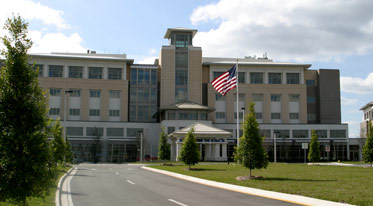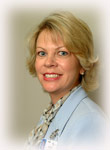Interviews
Do it Yourself Lean in the Lab
Hope Greig had a poster at the 2005 AACC/ASCLS/etc conference in Orlando, “Using Lean Thinking in staffing a new clinical laboratory.” After reading her poster, we followed up with an interview. Her experience provides a bench-level view of Lean and can offer some very practical observations about what to expect.
Lean in the Lab: A unique opportunity
Interview by Sten Westgard, MS
Ms. Greig was asked to design and staff the laboratory for a new hospital, Baptist Medical Center South, in Jacksonville, Florida. This new 92-bed hospital was built with 250,000 square feet, maximizing space for family and patients.
 When Ms. Greig began working on the blueprints, she realized that this challenge was actually a real opportunity to design the workflow of the laboratory from the ground up. Ms. Greig was fortunate enough to know colleagues in Scottsdale, Arizona who had recently implemented Lean management through a consultant. Drawing on the lessons and wisdom of their experience, (plus the power of the Internet), Ms. Greig decided to implement a Lean solution to the laboratory.
When Ms. Greig began working on the blueprints, she realized that this challenge was actually a real opportunity to design the workflow of the laboratory from the ground up. Ms. Greig was fortunate enough to know colleagues in Scottsdale, Arizona who had recently implemented Lean management through a consultant. Drawing on the lessons and wisdom of their experience, (plus the power of the Internet), Ms. Greig decided to implement a Lean solution to the laboratory.
Layout of the Lean Lab: Workcells
Ms. Greig began by eliminating the traditional discipline distinctions (chemistry, hematology, etc.) in favor of a workcell approach. All automated instrumentation was put in the same workcell. Another workcell was created for a semi-automated instruments (urinalysis, slides, etc.). Yet another workcell was reserved for manual methods, such as blood banking.
Lean concepts were used to strategically place instrument and work areas as closely together as possible to create physical process flows where effort and distance is minimized. This careful design concentrated 80% of the testing into the automated workcell.
Lean employees: cross-trained.
The laboratory at Baptist South is small and performs no esoteric testing. In many ways, it is a core laboratory. And in order to operate with Lean efficiency twenty-four hours a day, every employee in the laboratory is cross-trained on every workcell and technique. This is mandated by Lean management – if there is a process that needs extra help, everyone must be able to pitch in and get the work done.
Not surprisingly, these cross-trained workers need more training than your “average” technologist. To reach this level of skill, Ms. Greig asked for six weeks of training for each staff member, instead of the two weeks which management had originally budgeted. Now everyone on staff can do everything in the laboratory; each technologist holds five special licenses required by the state of Florida.
Results: TAT
As many of you know, Turn-Around Time is the squeaky wheel of laboratory service. The main source of complaints about laboratory performance is invariably how quickly test results are reported. To monitor and manage TAT, the laboratory's LIS provides regular reports on timing. The Baptist South hospital is meeting benchmarks for the hospital system, returning critical tests (potassium, hemoglobin, troponin, etc.) within one hour 90% of the time. A close analysis of the TAT results found that 97% of the tests are actually done, and the remaining problems are often due to outliers such as added-on tests.
To date, Ms. Greig has not received a complaint from the Emergency Department about turn-around time.
Results: Fewer Staff
At the end of her design, Ms. Greig found that she needed 3 fewer full time employees than were budgeted for her by management. The hospital expected 17.5 FTEs, but Ms. Greig's planning only needed 14. So she talked with her manager and they agreed to reduce the size of the laboratory staff.
When the hospital finally opened its doors, the patient and therefore test volume was nearly triple what had been projected, but the Lean staff was still able to handle the task. Since then, new technologists have been hired to handle the increasing workload and to reduce the overtime hours worked. The laboratory has contributed significantly toward the hospital's efficient operation, consistently remaining under budget in FTEs (full-time equivalents), which has contributed to the financial success of the new hospital.
Observations on a Lean staff
Ms. Greig is the first to admit that implementing Lean is not easy. It's work and there is no extra slack and no wasted time. This working environment requires the right people. People who are used to breaks and down-time, or who prefer the security of just one specialty, are not going to last long in a Lean environment. For those who hire staff for a Lean laboratory, extra care must be taken to insure the right people are hired. Otherwise, there will be increased turnover as staff members who don't adjust well to the increase in tempo burn out and resign.
There is also a need for increased leadership and commitment when managing a Lean staff. Managers should expect to see the Lean environment make a significant impact on their staff. And as staff are tempted to back off their skills, retreat into the old way of doing things, the managers must be firm, and reinforce the goals of Lean.
QC in a Lean Lab
While Lean made major changes to the workflow of the laboratory, it didn't make similar changes to the QC they performed. But the strong commitment to Lean is matched by a strong commitment to QC.
The staff is trained to use multirules, in the meaning of each rule and what must be done when each rule is violated. Everyone must run QC and document the results in the same manner. The lab watches the peer group and monthly QC results to monitor and eliminate bias issues. They also stay on top of control means and sds. Means are not changed for trivial reasons – and require strong documentation in order to change.
Ms. Greig states that she runs QC the same way that she has for the past ten years. She emphasizes that one of the purposes of using Lean thinking is to improve quality. Therefore, reducing QC wouldn’t make sense. However, we must note editorially, that such practices may now be unusual in laboratories. Clearly, Ms. Greig has brought an extraordinary dedication to QC and Lean in her laboratory.
Hope Greig
 Hope Greig joined Baptist Medical Center South from Putnam Community Medical Center in Palatka, where she spent the last five years as the Laboratory Administrative Director. Previously, she was the Laboratory Operations Manager for St. Luke's Hospital/Mayo Clinic Jacksonville. Although to the system, Hope brings over 18 years of clinical and leadership experience to her role as the Manager of Laboratory Services at Baptist Medical Center South.
Hope Greig joined Baptist Medical Center South from Putnam Community Medical Center in Palatka, where she spent the last five years as the Laboratory Administrative Director. Previously, she was the Laboratory Operations Manager for St. Luke's Hospital/Mayo Clinic Jacksonville. Although to the system, Hope brings over 18 years of clinical and leadership experience to her role as the Manager of Laboratory Services at Baptist Medical Center South.
Hope earned her Bachelors of Arts in Biology and her Masters in Health Science in Healthcare Administration from the University of North Florida. She is currently an adjunct professor of Health Science as well as a member of the Medical Laboratory Technology Advisory Board at Florida Community College of Jacksonville. She is credentialed as a Medical Technologist and Specialist in Clinical Chemistry by the American Society of Clinical Pathologists. Hope is an avid equestrian and resides in St. Augustine with her family.
We thank Ms. Greig for her help in preparing this article, as well as Baptist Medical Center South.
